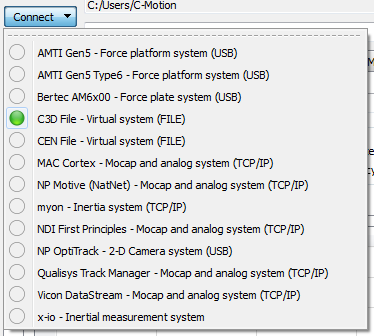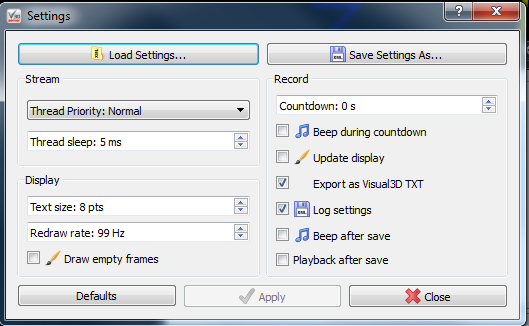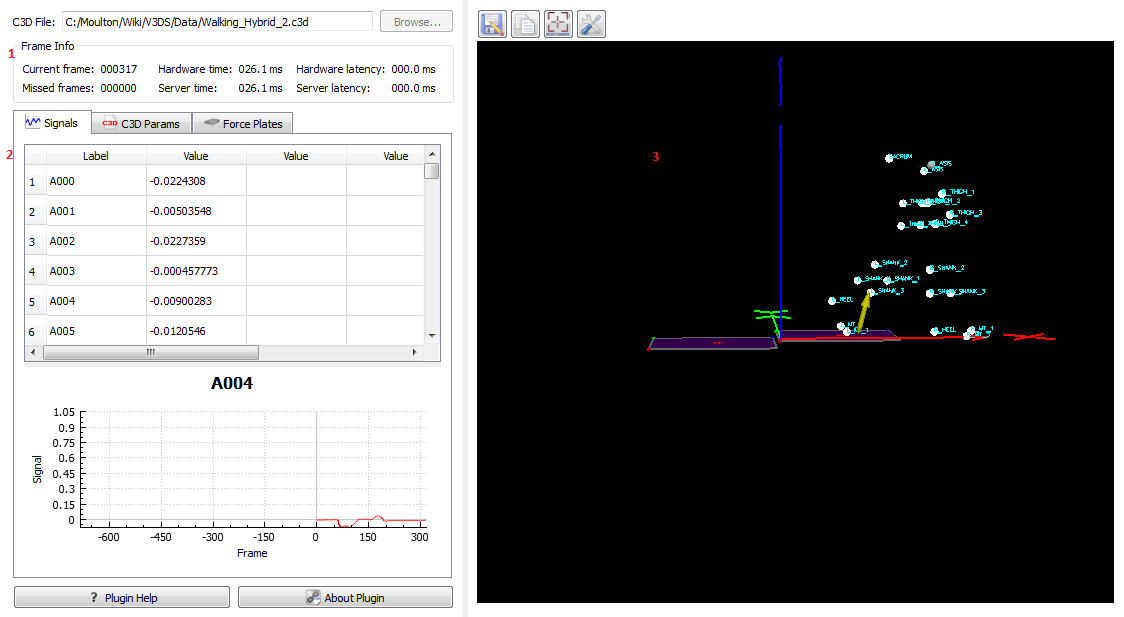Table of Contents
Setup C3D
Purpose
This tutorial shows you how to stream a pre-recorded C3D file through Visual3DServer. This is particularly useful if you want to test out the streaming process without a live subject present or if you wish to trouble shoot a newly created custom biofeedback application.
Steps
1. Making sure you have the data you need
Before beginning this tutorial make sure that you have:
1. Downloaded the file model.zip
2. Saved the file to where you would normally save motion capture files and unzip it.
3. Make sure that you have both Walking_Hybrid_2.c3d and model.cmo
These sample Qualysis files were downloaded from C3D.org.
2. Setting up the plugin
In order for Visual3DServer to find the C3D file you wish to stream you will need to enter its location in the C3D File Path dialogue box in the top left corner of the C3D Plugin screen. You can do this by either typing in the file path or using the Browse button to the right of the dialogue box.
3. General Settings
You may or may not wish to alter Visual3DServer's default settings. To access the Settings window, shown on the right, click on the Settings button, shown above, which is found at the bottom of the screen in the middle.
Load Settings - You can chose to load an .xml file which holds settings for a specific project instead of entering them manually.
Save Settings As- You can chose to save your settings as an .xml file so that they can be reused in the future without having to be manually set.
Thread Priority - Normal is the default and is usually fine for most projects. However, if you are running multiple programs and find that Visual3DServer is slowing down you can increase the priority level to avoid delays in streaming.
Thread Sleep - As long as the sleep time is smaller than the camera frequency time (in milliseconds), everything should work. Values of 1 through 5 are good choices so as to reduce the chances of missing the occasional frame.
If you set the thread priority to very high and the sleep time very low you will get the best capture performance, but the user interface (along with the rest of your computer) might become much less responsive.
Redraw Rate - The higher the redraw rate the smoother the movements in the graphics will appear. However, drawing at higher rates takes more of the computer's processing time and, depending on the speed of the computer, may result in frames being dropped. For practical purposes, the human eye cannot appreciate the difference of a redraw rate above 50 Hz.
Draw Empty Frames - Leaving the checkbox checked will result in smoother graphics however, you will have no visual indication that frames may be missing.
4. Connecting
| The Connect button is located in the top left hand corner of the screen. Left click on the button and you will be presented with a list of the plugins that you selected when you installed Visual3DServer. Note: if the plugin that you want to use is not in the list you will have to reinstall, paying particular attention to step 6 to make sure that you select all of the plugins that you will be using. There are two ways to see if a system or file is passing data to the Server. The first is to look at the plugin tab. A grey circle to the left of the system name means that there is no connection. A green circle means that there is a connection. The second way is to look at the Connect button drop down menu. The drop down menu to the right shows that the C3D file plugin is active and all of the other plugins are inactive. Plugins can be activated or inactivated with a left click to the system name on the Connect drop down menu. |  |
5. Confirm Connection
When a connection is successfully made you will see the following:
1. The frame info box will be keeping count of frames and frame times.
2. The signals table will show both force and marker data, if you click on one of the signals it will be plotted on the graph at the bottom.
3. The 3DView window will show a subject, with lower extremities markered, walking over two force plates.
Biofeedback Options
The C3D plugin can stream to any of the following biofeedback options:
- Visual3D Realtime (file may contain force data, marker data or both)
- SNRC WRNMMC BADER (file may contain force data, marker data or both)
It can also stream to custom biofeedback applications that you have built yourself.




